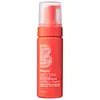What's inside
What's inside
 Key Ingredients
Key Ingredients

No key ingredients
 Benefits
Benefits

 Concerns
Concerns

 Ingredients Side-by-side
Ingredients Side-by-side

Water
Skin ConditioningCocamidopropyl Betaine
CleansingPolyquaternium-11
Butyrospermum Parkii Butter
Skin ConditioningCocos Nucifera Oil
MaskingMel
EmollientPanthenol
Skin ConditioningDecyl Glucoside
CleansingPEG-40 Hydrogenated Castor Oil
EmulsifyingPolysorbate 20
EmulsifyingParfum
MaskingSodium Hydroxide
BufferingBenzophenone-4
UV AbsorberCaprylyl Glycol
EmollientPhenoxyethanol
PreservativeCaramel
Cosmetic ColorantCI 14700
Cosmetic ColorantCI 19140
Cosmetic ColorantWater
Skin ConditioningDecyl Glucoside
CleansingGlycerin
HumectantVp/Va Copolymer
Pullulan
Prunus Domestica Seed Oil
Skin ConditioningSqualane
EmollientNiacinamide
SmoothingBiotin
AntiseborrhoeicFolic Acid
Skin ConditioningPolyglyceryl-3 Cocoate
EmulsifyingPolyglyceryl-4 Caprate
EmulsifyingHydrogenated Lecithin
EmulsifyingHelianthus Annuus Seed Oil
EmollientPolyglyceryl-6 Caprylate
EmulsifyingPolyglyceryl-6 Ricinoleate
EmulsifyingSodium Polyitaconate
Sucrose
HumectantCitric Acid
BufferingPanthenol
Skin ConditioningSodium Starch Octenylsuccinate
AbsorbentCalcium Pantothenate
Maltodextrin
AbsorbentSodium Ascorbyl Phosphate
AntioxidantPyridoxine Hcl
Skin ConditioningTocopheryl Acetate
AntioxidantCitrus Junos Peel Extract
Skin ConditioningSilica
AbrasiveParfum
MaskingDehydroacetic Acid
PreservativeBenzyl Alcohol
PerfumingWater, Decyl Glucoside, Glycerin, Vp/Va Copolymer, Pullulan, Prunus Domestica Seed Oil, Squalane, Niacinamide, Biotin, Folic Acid, Polyglyceryl-3 Cocoate, Polyglyceryl-4 Caprate, Hydrogenated Lecithin, Helianthus Annuus Seed Oil, Polyglyceryl-6 Caprylate, Polyglyceryl-6 Ricinoleate, Sodium Polyitaconate, Sucrose, Citric Acid, Panthenol, Sodium Starch Octenylsuccinate, Calcium Pantothenate, Maltodextrin, Sodium Ascorbyl Phosphate, Pyridoxine Hcl, Tocopheryl Acetate, Citrus Junos Peel Extract, Silica, Parfum, Dehydroacetic Acid, Benzyl Alcohol
Alternatives
Ingredients Explained
These ingredients are found in both products.
Ingredients higher up in an ingredient list are typically present in a larger amount.
Decyl Glucoside is a glucose-based surfactant and emulsion stabilizer. It is created by reacting glucose with the fatty acids from plants.
Surfactants help clean the skin by trapping oil, sebum, and dirt to be washed away. As an emulsion stabilizer, it stabilizes the ingredients in a product by preventing them from separating.
This ingredient is biodegradable and non-toxic. This ingredient is commonly found in baby shampoos.
Decyl Glucoside is sometimes used to stabilize the UV filter Tinosorb.
Learn more about Decyl GlucosidePanthenol is a common ingredient that helps hydrate and soothe the skin. It is found naturally in our skin and hair.
There are two forms of panthenol: D and L.
D-panthenol is also known as dexpanthenol. Most cosmetics use dexpanthenol or a mixture of D and L-panthenol.
Panthenol is famous due to its ability to go deeper into the skin's layers. Using this ingredient has numerous pros (and no cons):
Like hyaluronic acid, panthenol is a humectant. Humectants are able to bind and hold large amounts of water to keep skin hydrated.
This ingredient works well for wound healing. It works by increasing tissue in the wound and helps close open wounds.
Once oxidized, panthenol converts to pantothenic acid. Panthothenic acid is found in all living cells.
This ingredient is also referred to as pro-vitamin B5.
Learn more about PanthenolParfum is a catch-all term for an ingredient or more that is used to give a scent to products.
Also called "fragrance", this ingredient can be a blend of hundreds of chemicals or plant oils. This means every product with "fragrance" or "parfum" in the ingredients list is a different mixture.
For instance, Habanolide is a proprietary trade name for a specific aroma chemical. When used as a fragrance ingredient in cosmetics, most aroma chemicals fall under the broad labeling category of “FRAGRANCE” or “PARFUM” according to EU and US regulations.
The term 'parfum' or 'fragrance' is not regulated in many countries. In many cases, it is up to the brand to define this term.
For instance, many brands choose to label themselves as "fragrance-free" because they are not using synthetic fragrances. However, their products may still contain ingredients such as essential oils that are considered a fragrance by INCI standards.
One example is Calendula flower extract. Calendula is an essential oil that still imparts a scent or 'fragrance'.
Depending on the blend, the ingredients in the mixture can cause allergies and sensitivities on the skin. Some ingredients that are known EU allergens include linalool and citronellol.
Parfum can also be used to mask or cover an unpleasant scent.
The bottom line is: not all fragrances/parfum/ingredients are created equally. If you are worried about fragrances, we recommend taking a closer look at an ingredient. And of course, we always recommend speaking with a professional.
Learn more about ParfumWater. It's the most common cosmetic ingredient of all. You'll usually see it at the top of ingredient lists, meaning that it makes up the largest part of the product.
So why is it so popular? Water most often acts as a solvent - this means that it helps dissolve other ingredients into the formulation.
You'll also recognize water as that liquid we all need to stay alive. If you see this, drink a glass of water. Stay hydrated!
Learn more about Water